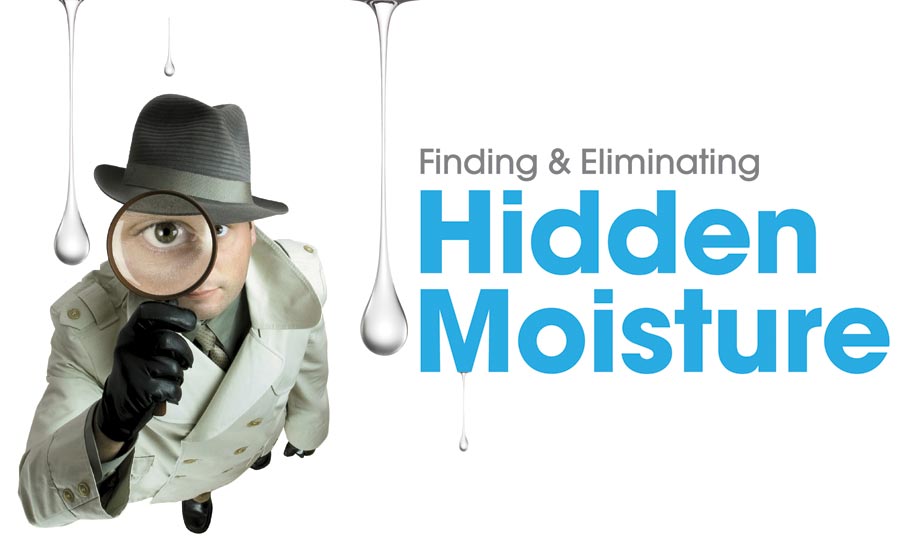Finding & Eliminating Hidden Moisture
Article written by Chris Spensley
Finding and efficiently eliminating areas of trapped hidden moisture is one of the many factors that differentiate an experienced restorer from a novice. If left untreated, these forgotten areas can lead to various forms of secondary damage and significantly complicate restorative efforts. Wet wall cavities are one of the most common hidden moisture scenarios technicians run into. And many different theories exist on how to handle these situations. Industry trade shows are full of different types of attachments and pieces of specialty equipment. That claim to make drying these areas easier. Are they necessary? When and in what circumstances? What is truly the best way to dry hidden moisture inside of wall cavities?
The four variables that dictate an effective approach are:
- The presence of wet insulation (or lack thereof),
- Finish wall materials,
- Structural composition of the wall itself, and
- The presence of a preexisting condition (or lack thereof).
First and foremost we must consider that the IICRC S500 instructs us that materials are dry. Once they reach predetermined drying goals, as measured with a moisture meter. If we do not open the wall cavity enough to allow the use of these tools. There is no way for us to ensure with certainty that all of the trapped moisture has been removed. Therefore, at the very least, we are using some form of invasive technique in the sense that the inside of the wall cavity must be accessed. This also allows us to inspect the cavity for insulation. And if found, must be removed when wet as insulation will pack down and lose its R-Value. Unfortunately, this leads to a disruptive method of drying as the walls are removed so the wet insulation can be discarded.
Next to be considered the material that the wall itself is composed of. In most restorative situations, we are dealing with gypsum drywall or another gypsum type assembly (such as Greenboard or similar). These materials tend to dry quickly after water damage as they have a rather high permeance factor which allows water vapor to diffuse through them. However, if the room side of the wall is covered with a finish material. Such as wallpaper, ceramic tile, or other vapor retarding material, drying can be hindered. These surfaces will affect the rate of evaporation of moisture within the material. In cases such as this, inspection holes can be drilled below the baseboard line to force air into the cavity for drying both sides of the wall simultaneously. If this method is unsuccessful, removal or perforation of the wall finish material may be necessary. As well as the installation of specialty wall cavity drying equipment.
The structural composition of the wall must be evaluated when choosing a drying method. In common residential settings, the typical scenario is 2×4 wood framing. However, in commercial settings, the presence of steel framing has the ability to pose complications. As the water inside the bottom track has the ability to travel great distances unnoticed. In addition, exterior building materials such as poured concrete, concrete block, and exterior wood sheathing need to be identified. As they are critical to restoring to our dry standard as well. At a minimum, wall cavities need to be opened (preferably below baseboard lines) in order to direct airflow and also be able to meter these materials.
Finally, we must make absolutely sure that no preexisting conditions are hidden in the cavities we are trying to dry. Installing air movers or using specialty drying equipment to add positive pressure in these areas can cross-contaminate unaffected spaces if there is hidden microbial damage lurking inside. In addition, the possibility of lead-based paint and asbestos must be considered as well.
Normal structural drying of wall cavities can only proceed if the three aforementioned conditions are not present. If they are found, this constitutes a Special Situation per IICRC Guidelines. And an Indoor Environmental Professional should be contacted to help dictate safe and effective work practices.
Good restorers will always consider keeping the cost of reconstruction work at a minimum to benefit both the customer and the insurance client. If possible, all wall cavities should be opened below baseboard lines to avoid painting large areas once the restoration is complete. The caulking on baseboards should always be scored before removal to ensure that finished wall surfaces are not damaged. Also, all cuts to drywall should be made with a chalk line for a professional appearance and expedited repair time.
While considering all of the aforementioned information, the following general conclusions can be drawn:
- Wet wall cavities must be opened so direct airflow can adequately dry affected materials. And also so these materials can be measured with a moisture meter.
- If found, wet porous insulation should always be removed as it will lose it’s R-Value and significantly slow the drying process.
- If presented with a difficult to dry or costly finish material on an interior wall, consider a more disruptive technique from the opposite side of the wall to save on overall cost.
- On an uninsulated drywall wall with 2×4 wood framing, the use of specialty drying equipment is not needed and adds unnecessary cost to the project. Drilling inspection holes below baseboard lines and placing air movers along the wall is sufficient.
- Specialty drying equipment may be required when drying wall cavities behind cabinets or when there is a vapor retarding wall covering (ceramic tile, wallpaper, etc).
Following these simple guidelines will help your company build the reputation of consistent and effective job processes homeowners and insurance clients alike will appreciate.

